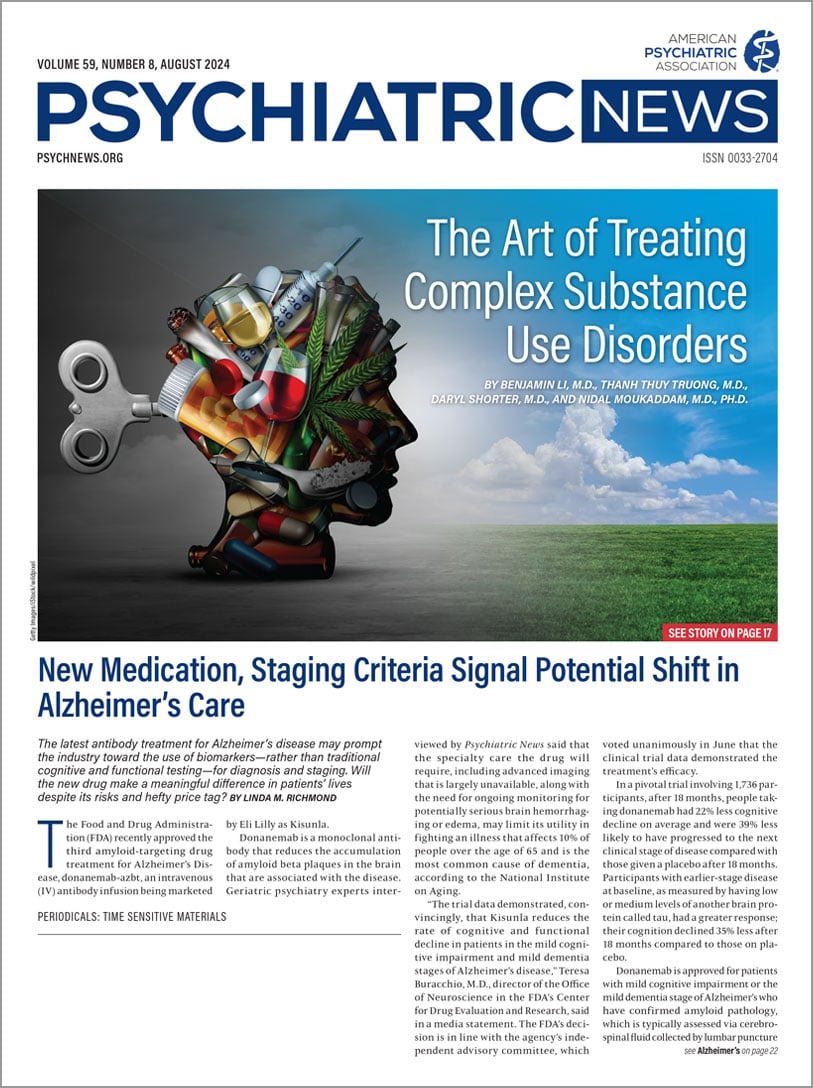Recent advancements in geriatric psychiatry research have allowed the creation of a new evidence-based algorithm for the treatment of patients with difficult to treat late-life depression, according to two experts in the field who spoke at this year’s Annual Meeting.
The complexity of late-life patient care has increased exponentially in psychiatry in just a few decades, said Eric J. Lenze, M.D., professor and chair of the Department of Psychiatry at the Washington University School of Medicine in St. Louis. There are far more treatments available than before, including new antidepressants, augmentation agents, and interventional choices like brain stimulation.
Thirty years ago, a typical patient presenting with late-life depression might be a 65-year-old woman, with no history of mental health treatment, and taking just three medications for arthritis, hypertension, and coronary artery disease. Today, a typical patient might be 78 years old, with heart failure, stage 3 renal disease, diabetes, hypertension, and five past-year hospitalizations. She might be taking 25 medications, many of which may be CNS (central nervous system)-active, drinking alcohol daily, and taking “gummies” for sleep.
“Have you ever looked at a patient’s medication list and scratched your head, wondering ‘How did they get there?’ With so many treatments available, it raises the question of which one to choose,” Lenze said. “However, we now have enough high-quality data to create an algorithm that considers the best available data to maximize benefits and minimize risks.”
Lenze’s treatment algorithm for treating late-life depression is as follows:
•
First-line treatment: SSRIs, which have a greater than 50% remission rate. SSRIs work as well as
tricyclics in this population, but without as many side effects. Escitalopram or sertraline are least likely in this class to cause drug interactions or anticholinergic or other off-target effects, Lenze said. After achieving remission,
research results favor continuing the medication for maintenance, he added.
•
Second-line treatment: SNRIs. Lenze said desvenlafaxine, venlafaxine, and duloxetine should be top of mind for patients who don’t improve on an SSRI because they have few or no off-target effects or drug interactions. About half of older patients taking an SNRI reach remission (47%); that is, unless the patient has already tried one and it didn’t work well, Lenze explained. Recent
research shows that venlafaxine remission rates are inversely correlated with the number of prior trials with these medications (66% for patients no prior adequate trials, 45% for one prior trial, and 23% for two or more).
•
Third-line strategy: augment with aripiprazole. Aripiprazole appears to be a relatively effective, well-tolerated, and safe augmentation agent for treatment-resistant depression in older adults, according to
research published by Lenze, Karp, and colleagues. (However, tolerability concerns include akathisia and Parkinsonism, the study found.)
Another
study by this group found that 10 weeks of aripiprazole augmentation improved the chance of remission and psychological well-being significantly more than a switch to bupropion. Although bupropion augmentation also had a large positive effect, aripiprazole augmentation resulted in 67% fewer falls, Lenze explained. “Antidepressants in general are associated with an increase in falls in older adults, because they can cause orthostasis, dizziness, reduced reaction time, and unsteadiness in gait.”
•
Fourth-line strategies: neuromodulation, ketamine, or ultra-brief unilateral electroconvulsive (ECT) therapy. Overall, studies have found that neuromodulation and ketamine have a 40% to 50% response rate for late-life depression, Lenze said. One
pilot study using 8 weeks of repeated intravenous ketamine in older patients found that the treatment was well tolerated, safe, and that 48% had a positive response.
Another study found that
ultra-brief unilateral ECT is associated with fewer memory side effects and is better tolerated than traditional ECT among older patients. In addition, nearly 62% of patients reached remission after an average of seven treatments.
Jordan F. Karp, M.D., professor and chair of the Department of Psychiatry at the University of Arizona College of Medicine in Tucson, said the complexity of today’s late-life patients requires psychiatrists to wear many hats, including that of primary care doctor and social worker. “I address patients’ cognition, living conditions, loneliness, driving, finances, multi-morbidities, and pain. It is especially important to ensure diabetes and sleep apnea, if present, are effectively treated.”
Karp gave several additional tips to optimize treatment of late-life depression, including the following:
•
Be careful that stigmatizing ageism doesn’t creep in and affect the quality of outcomes, Karp said. Common ageist behaviors include prioritizing younger patients, showing a lack of patience and respect, excluding older patients from medical decision-making, and using condescending “elderspeak,” such as “sweetie” or “honey.”
•
Leverage medical assistants and nurses to do a quick phone check-in two weeks after appointments. “As many as 40% of patients never fill their prescriptions or stop taking them because of emergent side effects. You don’t want to wait two months to find that out.”
•
Advise patients to think about depression treatment in 6-month “chunks of time.” “Most don’t want to think about staying on antidepressants forever,” he said. After six months, he presents information on the potential risks versus benefits of continuation.
•
Charter a course with patients and position yourself as the expert. “If you’re engaged in an algorithmic, measurement-based course of treatment, then be confident with patients about what’s best when advising them.”
•
Engage family supports and make sure they’re on board with the treatment.
Clinical inertia and therapeutic nihilism often interfere with better outcomes for older adults, Karp said. For example, clinicians are less likely to optimize dosing and more likely to miss residual symptoms when treating late-life depression. Common reasons include ageism, an erroneous assumption that nothing can be done about depression in older patients, and a lack of clinic appointments to schedule needed follow-ups. Yet treating late-life depression is feasible and one of the most cost-effective ways to improve older adults’ quality of life and minimize disability, Karp said. ■


